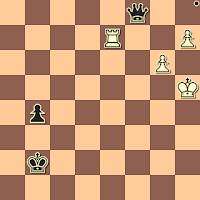Yet, that is what this post is all about.
Let's take a look at a line of play mentioned in a blog post on this site, 9 years ago, "An International Master Refutes the Jerome Gambit".
You might think from the title of the blog post that the IM is a little bit late to the party - who hasn't refuted the Jerome Gambit?
Actually, IM Gary Lane has been supportive of the Jerome, covering it - with whimsey - in his The Greatest Ever Chess Tricks and Traps (Everyman Chess, 2008) and a couple of times in 2012 in his "Opening Lanes" columns at ChessCafe.com. (I do not think that the Chess Cafe site currently works.)
Let's see some of what he has to say.
1.e4 e5 2.Nf3 Nc6 3.Bc4 Bc5 4.Bxf7+
4...Kxf7 5.Nxe5+ Nxe5 6.Qh5+ Ke6 7.f4 d6
I have called this the "annoying defense" (because it is) or the "silicon defense" (because of the affinity computer chess programs have for it). It was first seen in D'Aumiller - A.P., 1878 and figured in six of Alonzo Wheeler Jerome's games against S.A. Charles in their unfinished 1881 correspondence match.
Lane:
I think this is the best way to defend: allowing one of the extra pieces to be taken, and in return obtaining a solid position with extra material.8.fxe5 dxe5 9.Nc3
Lane, again:
This is the right time for White to offer a draw, but if the offer is declined you should remember that it is frowned upon to cry at the board.Funny guy - but wait! I finished up that blog post with
I was pleased to see that 9.Nc3 was not in my Jerome Gambit database – but if that is the move IM Lane sees as best for White, I will add it to my repertoire!So - whatever happened to 9.Nc3 ?
A quick look at The Database (and then, this blog) shows that later in 2009, the Scacchi64.com website held a computer vs computer Jerome Gambit tournament. Comet B48 played the move 9.Nc3 four times, winning twice and losing twice.
Also, Steve Wall played 9.Nc3 once in 2013, while his brother, Bill, played it once in 2015 and once in 2017 - all told, with a win, a draw, and a loss.
A handful of computers and a couple of brothers - that's almost keeping 9.Nc3 a "secret". Here's one of Bill's games, so you can decide what you think for yourself - it's long and complicated, and a Jerome Gambit loss for Bill is pretty rare, so afterwards you might decide you want to keep the line a secret, after all.
Wall, Bill - Guest446794, PlayChess.com, 2017
1.e4 e5 2.Nf3 Nc6 3.Bc4 Bc5 4.Bxf7+ Kxf7 5.Nxe5+ Nxe5 6.Qh5+ Ke6 7.f4 d6 8.fxe5 dxe5 9.Nc3 Nf6 10.Qe2 Ke7 11.Na4 Qd4 12.Nxc5 Qxc5 13.d3 Bg4 14.Be3 Qb4+ 15.Qd2 Qxd2+ 16.Kxd2 Rhd8 17.Kc3 Be6 18.h3 b6 19.a4 Rf8 20.a5 Nh5 21.Rhf1 Ng3 22.Rfe1 Kd6 23.b4 Bd7 24.Kb3 Nh5 25.c4 Nf4 26.Ra2 g5 27.Kc3 Rg8 28.d4 exd4+ 29.Bxd4 c5 30.bxc5+ bxc5 31.Be3 Kc6 32.Rd2 Rae8 33.Bxc5 Bxh3 34.Bxa7 Bxg2 35.e5 h5 36.Rd6+ Kb7 37.Rd7+ Kc6 38.Rd6+ Kc7 39.Rh6 Rh8 40.Rf6 Kd7 41.Rd1+ Kc8 42.Rb1 Rh7 43.Rb8+ Kd7 44.Rd6+ Ke7 45.Rb2 Rc8 46.Rbd2 Rf7 47.Be3 Bf1 48.c5 Rf5 49.Rd7+ Kf8 50.Rf2 Bb5 51.Rh7 Be8 52.Kd4 Ne6+ 53.Kc4 Rxf2 54.Bxf2 Nc7 55.e6 Nxe6 56.a6 Ra8 57.a7 Nd8 58.Be3 Kg8 59.Rh6 g4 60.Bd4 Kf8 61.Rh8+ Ke7 62.Rh7+ Bf7+ 63.Kb5 Ne6 64.Be5 Rxa7 65.c6 Ra2 66.b6 Rc2 White resigned










